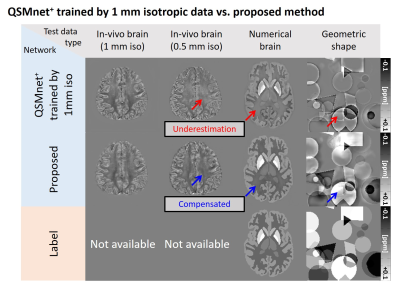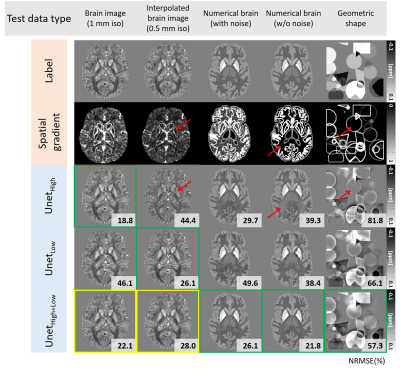Woojin Jung1, Steffen Bollmann2, Se-Hong Oh3, Hyeong-geol Shin1, Sooyeon Ji1, and Jongho Lee1
1Department of Electrical and Computer Engineering, Seoul National University, Seoul, Korea, Republic of, 2The University of Queensland, Brisbane, Australia, 3Biomedical Engineering, Hankuk University of Foreign Studies, Yongin, Korea, Republic of
1Department of Electrical and Computer Engineering, Seoul National University, Seoul, Korea, Republic of, 2The University of Queensland, Brisbane, Australia, 3Biomedical Engineering, Hankuk University of Foreign Studies, Yongin, Korea, Republic of
We identified that
the spatial gradient distribution in the training data is an important factor for
deep-learning based QSM and demonstrate that augmenting the spatial gradients
improves the performance for varying image resolutions.

Figure 1. Reconstruction results of
QSMnet+ in various test data types. Underestimations in
susceptibility values are observed (red arrows) in the higher resolution (0.5 mm)
in-vivo brain, numerical brain, and geometric shape images. To overcome this
limitation, we propose a data augmentation method to expand the diversity of spatial gradient of training images. The underestimation is reduced in the
proposed method (blue arrows).

Figure
4. QSM maps of the five inputs from Figure 3 reconstructed by the three networks (UnetHigh, UnetLow, and UnetHigh+Low).
The ground-truth susceptibility maps and corresponding spatial gradient maps
are shown in the first two rows. The best performance is highlighted by green
boxes. As highlighted by red arrows, the network with high spatial gradient (UnetHigh) underestimates
susceptibility values in low spatial gradient regions, revealing training data
dependency. The augmented UnetHigh+Low shows high
performance in all inputs (yellow and green boxes).